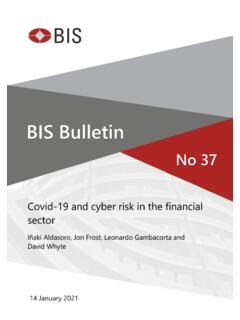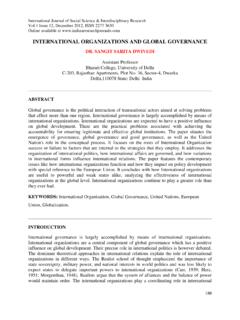Transcription of Project Dunbar - International settlements using multi-CBDCs
1 Project Dunbar International settlements using multi-CBDCs March 2022. Contents 01 Executive summary 2. 02 Introduction 3. 03 International settlements with multi-CBDC 8. Expected benefits 9. 04 Critical challenges 11. Access Jurisdictional boundaries Governance 05 Designing for a multi-CBDC common platform 12. 06 Governance 14. Access considerations 14. General principles for shared platform 18. Decision-making considerations 19. 07 Processes 22. High-level cross-border payments flows 22. Cross-border settlement 23. Non- settlement processes 23. Foreign currency exchange 24. 08 Technology 26. Infrastructure 26. Applications 29. 09 Summary and next steps 30. Appendix Dunbar capabilities and considerations 35. Prototype developed by R3 on Corda platform 37. Prototype developed by Partior on Quorum platform 53. Glossary of Terms 61. Project Dunbar International settlements using multi-CBDCs | 1.
2 Executive summary 01. Project Dunbar explores how a common and 8. The technical design of the prototypes is platform for multiple central bank digital summarised in Section 8, with further details of currencies ( multi-CBDCs ) could enable cheaper, the technical prototypes developed by R3 and faster and safer cross-border payments. The Partior available in the appendix. Project is a collaboration between the Bank for International settlements (BIS) Innovation Hub The final part of the report suggests areas for Singapore Centre, the Reserve Bank of Australia, further exploration and would be of interest to Bank Negara Malaysia, the Monetary Authority of policymakers and technologists. As one of the Singapore and the South African Reserve Bank. first technical experiments in the nascent space of multi-CBDCs , Project Dunbar focused as much This initial phase of the Project successfully on identifying problems as on solving them, and developed working prototypes and demonstrated ended with more questions than answers and practicable solutions, achieving its aim of proving with more questions than before it started.
3 Open that the concept of multi-CBDCs was technically questions and challenges were identified and viable. The prototypes validated the design categorised across the areas of policy, business approaches taken to resolve three critical sets of and technology. Key milestones and next steps challenges relating to access, jurisdictional were also identified. boundaries and governance. This final section describes problem statements The first part of the report provides a broad that need to be explored in the multi-CBDC. overview of the multi-CBDC space, including key space and constitutes an open call for benefits and challenges, and would be of interest collaboration to the central banking community, to policymakers. This starts in Section 2, which banking and payments companies, and the explains the motivations for the Project and the broader blockchain technology ecosystem.
4 Approach to achieving its objectives. Section 3 Multi-CBDC common platforms could make elaborates on the expected benefits of a multi- cross-border payments cheaper, faster and safer CBDC platform, explaining how cross-border and see them approach the efficiency of payments can be made faster, cheaper and safer domestic payments systems that we are familiar through reduced reliance on intermediaries, with. However, this is a journey that we must take simplification of settlement processes, together. consolidation of common processes and process automation using smart contracts. Section 4. explores three critical challenges of implementing a multi-CBDC platform. The second part of the report describes the design of a multi-CBDC platform and would be of interest to technologists. An overview of the foundational capabilities required in a multi- CBDC platform is outlined in Section 5, which describes its capabilities across the areas of governance, processes and technology.
5 Each of these is covered in greater depth in Sections 6, 7. 2 | Project Dunbar International settlements using multi-CBDCs Introduction 02. Project Dunbar is a collaboration between Inefficiencies of the Bank for International settlements (BIS) cross-border payments today Innovation Hub Singapore Centre, the Reserve This fragmented network results in cross-border Bank of Australia (RBA), the Bank Negara payments being generally slower, opaque and Malaysia (BNM), the Monetary Authority of more expensive compared with domestic Singapore (MAS) and the South African Reserve payments. A single cross-border payment might Bank (SARB) to explore how a common platform pass through multiple correspondent banks using for multiple central bank digital currencies the foreign currencies held with them. Each leg of (CBDCs) could enable cheaper, faster and safer the overall transaction takes time and effort to cross-border payments.
6 Process, with fees levied that add up quickly and are passed on to customers, resulting in slow and The area of cross-border payments is complex costly cross-border payments. with multiple challenges, although several projects are underway to address them. One key challenge In addition, there are significant operational is fragmentation, which Project Dunbar looks to processes that are needed to comply with address by exploring a common platform for regulations such as foreign exchange controls cross-border settlements that allows participating and anti-money laundering/countering financing central banks and financial institutions to transact of terrorism (AML/CFT) measures. These directly with each other in CBDCs. processes, such as enhanced due diligence (EDD). and know-your-customer (KYC) processes, are Background often manual and must be performed in each Cross-border payments are fund transfers for jurisdiction and by multiple parties in order to which the sender and the recipient are in satisfy the unique requirements imposed by different jurisdictions.
7 Such payments can be respective regulators. further classified into wholesale and retail payments. Project Dunbar focuses on wholesale Global efforts to improve cross- payments between banks (interbank payments). border payments Globally, cross-border payments lag significantly Unlike domestic payments, where banks can pay behind domestic payments in meeting user each other directly on a single national payments expectations for services. Faster, cheaper, more platform, there is currently no single International transparent and more inclusive cross-border platform for cross-border payments and payments could have widespread benefits for settlements leveraging CBDCs. Today, the citizens and economies worldwide, supporting correspondent banking model is used, where economic growth, International trade, global banks hold foreign currency accounts with each development and financial inclusion.
8 Other. To complete a single cross-border transfer, multiple correspondent banks may be involved, In October 2020, the G20 endorsed an ambitious with transactions recorded on multiple ledgers roadmap to enhance cross-border payments on multiple systems built on different around the world. The G20 roadmap was technologies and communicating in different developed by the Financial Stability Board (FSB). message formats. in coordination with the BIS Committee on Payments and Market Infrastructures (CPMI) and other International bodies. It sets out a five-year programme to address various frictions in retail See Bank for International settlements et al, Central bank digital currencies for cross-border payments , 2021, See Financial Stability Board (2020), Enhancing Cross-border Payments Stage 3 roadmap. Project Dunbar International settlements using multi-CBDCs | 3.
9 And wholesale cross-border payment been projects on cross-border payments using arrangements that contribute to the challenges CBDCs through bilateral connectivity, such as of high cost, low speed, limited access and Jasper-Ubin by the Bank of Canada and the MAS. insufficient transparency. Building block 19 of the G20 roadmap seeks to The G20 roadmap aims to address these factor an International dimension into CBDC. interrelated problems through 19 building designs , and this has led to growing interest in blocks (ie workstreams) that will be run in exploring models through which multiple CBDCs parallel over the course of the plan by the could be used for cross-border payments (so- relevant International organisations and called multi-CBDC arrangements). Three standard-setting bodies (Figure 1). conceptual models for multi-CBDCs were described in a recent paper by the BIS.
10 CBDCs as a potential solution compatible CBDC systems (model 1), interlinked One focus area of the G20 roadmap is in new CBDC systems (model 2) and a single system with payments infrastructures and arrangements, multiple CBDCs (model 3). which includes CBDCs. CBDCs show great promise in terms of improving payments, and have been the subject of exploration by multiple What is a CBDC? central banks. In simple terms, a CBDC is a digital banknote. It could be used by individuals to pay businesses or other individuals (a retail CBDC). Prior explorations have focused on the use of or it could be used by financial institutions CBDCs for domestic payments. Examples of or other wholesale market participants to projects by our Project partners include Project settle trades in financial markets or other Atom by the RBA, Project Ubin by the MAS and transactions (a wholesale CBDC).












